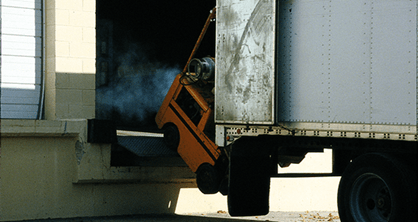Taking a load off
Don’t sit by the dock at the bay.
The Canadian trucking industry is not solely focused on the safety of driving trucks. Loading docks play a crucial role in the trucking fulfillment process, but they are often overlooked as a potential source of frequent accidents, delays, and even bay area shutdowns due to toxic spills.
According to the Workplace Safety and Prevention Services, load areas are typically congested with equipment, goods, and people. They are sometimes exposed to weather conditions and often poorly laid out and inadequately lit. These conditions easily lead to injuries and property damage. However, loading docks are frequently the most neglected and underfunded areas of the workplace.
Chuck Leon, a Warehouse and Racking Specialist from WSPS, points out, “Loading docks don’t receive the same attention as lifting equipment or racking systems might receive.” In some cases, they are not even included on inspection checklists. This oversight has not gone unnoticed by Ontario’s Ministry of Labour, Training, and Skills Development. Chuck mentions that inspectors regularly issue orders for inadequate inspection and maintenance of shipping and receiving areas related to loading docks.
Before managing hazards, it is important to identify, categorize, and create a checklist. Here are Chuck’s top 13 inspection items for loading docks:
1. Are dock approaches free from potholes and deteriorated pavement?
2. Are dock bumpers in good repair?
3. Are trailer positions marked with lines or lights to ensure accurate trailer spotting?
4. Are trailer wheel chocks used to block trailers and prevent movement during loading and unloading operations?
5. Are there two trailer wheel chocks for each trailer? (Note: The law only requires that wheels be “secured,” but chocks are the most common solution to prevent trailer movement.)
6. Are trailer wheel chocks chained to the building? Is there a holding rack for the chocks?
7. Are warning signs or warning lights being used?
8. If dock levelers are used, are they in proper working order?
9. Are the loading docks inspected according to the recommendations of the manufacturers?
10. Do all dock workers and visitors wear personal protective equipment?
11. Is the lighting adequate for the task being performed?
12. Is snow removed from the loading dock during the winter?
13. Are the loading docks inspected outdoors during the winter months?
All hazards are manageable.
To reduce docking incidents. Implement control measures and find ways to optimize.
|
|
|
|
|
|
Truck drivers dedicate a considerable amount of time on or near loading docks. It is crucial to adhere to all safety rules and regulations, as workplace injuries and accidents are common in warehouses and loading docks. It is imperative that both staff and truck drivers prioritize viewing the docking area as a potential safety hazard. Various elements such as floors, ramps, material handling equipment, dock plates, dock levelers, and turning areas all present potential safety concerns.
Keep live working environments safe through proper rehearsed communication signals.
Wear all current safety gear and follow all rehearsed safety procedures.
Create safety guidelines and a checklist for your docking areas. Include these topics…
| Vehicle Restraining Systems | Dock Levelers/Plates/Ramp | Dock Barriers and Bumpers | Dock Doors and Seals | General Loading and Unloading Procedures | Loading Dock Housekeeping |
| Loading Dock Signage | Loading Dock Inspections | Loading Dock Preventive Maintenance | Emergency Equipment and Response | Training | Personal Protective Equipment (PPE) |
| Safe Work Guidelines |
Here are some of the most common loading dock hazards identified by the Workplace Safety & Prevention Services (WSPS), along with steps you can take to avoid them:
1. Stay Out of the Way:
Forklift accidents are frequent on loading docks, and the machinery involved can be extremely dangerous. Forklifts account for over 90,000 injuries annually. They can topple, fall off edges, and knock over smaller items. Workers can also get trapped between the forklift and the pallet if they are not cautious. Pay close attention and keep a safe distance from forklift drivers while they are moving freight.
2. Restrain the Truck:
Trailer creep is a concern on loading docks. Accidents can occur when trucks separate from the dock and roll away. Fall-through accidents can happen if a forklift or a person falls into the gap between the dock and the trailer. Additionally, people below the dock could be injured if objects fall through the gap and strike them. To prevent such incidents, ensure that the truck is properly restrained. Wheel chocks are typically acceptable, but some trucking companies may require additional vehicle restraints to minimize the risk of fall-through accidents.
3. Communicate:
When your truck is backing up to a dock, be aware of your surroundings. Breakdowns in communication or not paying attention to what’s happening behind your truck can lead to workers being crushed between the truck and the dock. Observe and rehearse safety signals to ensure clear and effective communication.
4. Turn Your Truck Off:
Carbon monoxide poses a serious potential hazard at loading docks. Inadequate ventilation in warehouses can quickly become life-threatening within minutes. Idling trucks can worsen ventilation issues and emit toxic fumes. After docking your truck, make sure to turn it off and avoid idling while waiting for it to be loaded.
In conclusion, prioritizing safety in trucking dock areas is crucial. It is important to ensure that all workers are well-informed, trained, and adhere to loading dock safety rules. By following these guidelines and recommendations, you can help prevent serious accidents, injuries, and downtime in the docking workplace.



















